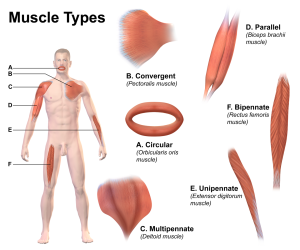University of Hawai‘i at Mānoa Food Science and Human Nutrition Program and Human Nutrition Program
The muscular system allows the body to move voluntarily, but it also controls involuntary movements of other organ systems such as heartbeat in the circulatory system and peristaltic waves in the digestive system. It consists of over six hundred skeletal muscles, as well as the heart muscle, the smooth muscles that surround your entire alimentary canal, and all your arterial blood vessels (see Figure 2.24 “The Muscular System in the Human Body”). Muscle contraction relies on energy delivery to the muscle. Each movement uses up cellular energy, and without an adequate energy supply, muscle function suffers. Muscle, like the liver, can store the energy from glucose in the large polymeric molecule glycogen. But unlike the liver, muscles use up all of their own stored energy and do not export it to other organs in the body. Muscle is not as susceptible to low levels of blood glucose as the brain because it will readily use alternate fuels such as fatty acids and protein to produce cellular energy.
Figure 2.24 The Muscular System in the Human Body

Learning Activities
Technology Note: The second edition of the Human Nutrition Open Educational Resource (OER) textbook features interactive learning activities. These activities are available in the web-based textbook and not available in the downloadable versions (EPUB, Digital PDF, Print_PDF, or Open Document).
Learning activities may be used across various mobile devices, however, for the best user experience it is strongly recommended that users complete these activities using a desktop or laptop computer and in Google Chrome.
Electrically charged ions dissolved in a solution. Commonly refers to sodium, potassium, and chloride.
A complete living system capable of conducting all of life’s biological processes.
A group of tissues that performs a specialized function.
A substance in food that can provide energy, contribute to body structure, and/or regulate body processes.
The organ system that includes the brain and spinal cord responsible for sensing changes in the external environment and creating a reaction to them.
